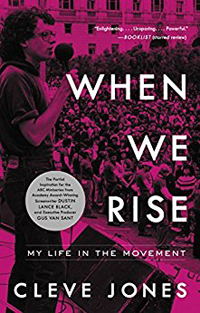
Cleve Jones, When We Rise; My Life in the Movement (New York: Hachette, 2016), 291pp.
Cleve Jones' life started off in one place and ended up in quite another one. A lonely teenager in the Phoenix suburbs, he "was born into the last generation of homosexual people who grew up not knowing if there was anyone else on the entire planet who felt the way that we felt." The social isolation, bullying, and violence that he experienced led him to the brink of suicide, were it not for the cover of a 1971 Life Magazine that he happened to see in the school library when he was seventeen — "Homosexuals in Revolt!" it exclaimed.
The next year he told his parents that he was gay, and in the following summer of 1973 he went to San Francisco. He had no money, no job, no bed, or even any plan, except to "join the revolution." As a street kid he panhandled, hustled, did a stint as a bike messenger, bought and sold drugs, sold his body when needed, and discovered the bath houses. And so in a blurb on the dust jacket, the writer Rebecca Solnit describes Cleve's story as one of "radical excess." He's lucky to be alive, especially given his own diagnosis of HIV-AIDS at the age of thirty-one.
Remarkably, Jones ended up leading millions of people in the gay liberation movement that at first he didn't even know existed. By the time that Harvey Milk was elected to the San Francisco Assembly in 1977, Jones had earned his bona fides as a movement leader. After Milk's assassination, Jones went on to help found the SF AIDS Foundation. In 1987, he conceived of the NAMES Project AIDS Memorial Quilt that memorializes 85,000 Americans who have died of AIDS. I read this book of personal memoir and political history after seeing Jones featured on the NPR News Hour.


